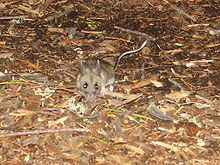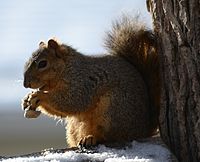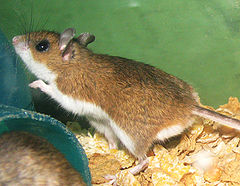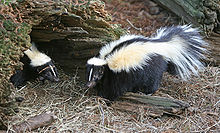VA AG Fears DC Law May Relocate Rehabilitated Rat Families To Virginia
“They have to capture them–then capture them in families. [Not sure] how you’re going to figure that out with rats. And then you have to relocate them. That brings us to Virginia. Now, if you don’t relocate them about 25 miles away, according to experts, rodents will find their way back. Well, an easy way to solve that problem is to cross a river, and what’s on the other side of the river? Virginia.”
(CNSNews.com) — Virginia Attorney General Ken Cuccinelli says he is worried that a new District of Columbia law that governs how pest control operators must handle rats may result in entire rodent “families” being relocated across the Potomac River into Virginia by D.C. pest control personnel.
Lately, there have been reports of growing rat infestations around the Occupy DC protests at Freedom Plaza and McPherson Square.
Cuccinelli said D.C.’s new rat law–the Wildlife Protection Act of 2010 (Wildlife Protection Act of 2010.pdf) –is “crazier than fiction” because it requires that rats and other vermin not be killed but captured, preferably in families; no glue or snap traps can be utilized; the rodents must be relocated from where they are captured; and some of these animals may need to be transferred to a “wildlife rehabilitator” as part of their relocation process.
The law does not allow pest control professionals “to kill the dang rats,” Cuccinelli told CNSNews.com. “They have to capture them–then capture them in families. [Not sure] how you’re going to figure that out with rats. And then you have to relocate them. That brings us to Virginia. Now, if you don’t relocate them about 25 miles away, according to experts, rodents will find their way back. Well, an easy way to solve that problem is to cross a river, and what’s on the other side of the river? Virginia.”
“So we have real concerns about this ridiculous–ridiculous!–law and we’ve been pretty genial about dealing with D.C. on it,” said Cuccinelli. “But when you see an article like the ‘Rats Occupy Occupy DC,’ it points up the problem that we’re going to have in Virginia because of that–and because D.C’s really outrageous–outrageous!–treatment of these varmints who, for those who don’t remember their history, carried things like bubonic plague. I mean, these are true vermin.”
While the law exempts “commensal rodents”–varieties of which most people know (or have seen) as common rats or house mice–the rice rat and deer mouse, which are found in the District, are not defined as commensal and apparently are not exempt from the law. In addition, the new law expands the definition of wildlife and sets the rules for handling it to include raccoons, squirrels, skunks, and other animals that can carry disease, such as rabies. The law applies to trained animal control officers, not to homeowners.
The law (Wildlife Protection Act of 2010.pdf) specifically says that wildlife “shall include any free-roaming wild animal, but shall not include: (A) Domestic animals; (B) Commensal rodents; (C) Invertebrates; and (D) Fish.” Commensal rats include the House mouse (Mus musculus), the Norway rat (Rattus norvegicus), and the Roof rat (Rattus rattus).

White foot mouse. (AP Photo)
In an e-mail to CNSNews.com, Brian Gottstein, communications director for Attorney General Cuccinelli, said, “While certain commensal rodents are exempted from the law, the rice rat and the deer mouse are species that wildlife control experts note are within the District that are NOT defined as commensal rodents, so they would appear not to be exempt from the law.”
“In addition to these particular rats and mice, raccoons, squirrels, skunks and other animals known to carry rabies, Lyme disease, and other diseases are not exempt from the law,” said Gottstein.
Gene Harrington, governmental affairs director for the National Pest Management Association, told CNSNews.com in an e-mail that he could not say “with any degree of accuracy how prevalent the deer and white-footed mouse and rice rat are in the District” but “that the largest deer and white-footed mouse populations likely live in Rock Creek Park, and that during the colder months they make their way into homes and other structures near or adjacent to the Park.” He later said that the deer and white-footed mice would likely be found in Ft. Dupont Park, the National Zoo, and the surrounding properties in D.C.
Harrington further said, “I suspect once the Occupy DC protesters eventually leave there will be an overly aggressive squirrel population that has gotten too used to being fed by humans. Under the Wildlife Protection Act, the only legal method pest and wildlife management professionals can use to manage these squirrels will be to live-trap them. Since the squirrels will associate humans with food there is really no place to relocate them where they would not eventually become a nuisance.”
“Also, keep in mind that a pest management professional’s use of snap traps at the Occupy DC camps to control the rats comes with its own legal pitfalls because squirrels or chipmunks could be attracted to the same peanut butter put out for the (Norway) rats,” said Harrington.
He continued, “Basically, federal and local government regulations have tied legal District rodent control practices in knots and made the management of such a problem much more complicated than it should be.”
The Wildlife Protection Act was sponsored by D.C. City Council Member Mary M. Cheh. It was introduced in 2009, passed in December 2010 and went into effect in March 2011.
Some of the law’s rules state (Wildlife Protection Act of 2010.pdf):
… (c) Traps used by a wildlife control services provider shall be set in a manner designed to catch the target animal and in the manner likely to avoid capture of and harm to non-target animals.
(d) Wildlife shall be captured, handled, and, when permissible, transported, in a manner to ensure against causing unnecessary discomfort, behavioral stress, or physical harm to the animal, including providing protections against weather extremes.
… (f) Captured non-target wildlife shall be released immediately at the site of capture. Captured non-target wildlife that pose an unreasonable risk to the health and safety to persons or domestic animals or that are injured and need veterinary care and rehabilitation shall:
(1) With permission of the property owner, be relocated to a suitable location where nuisance problems are unlikely to occur;
(2) Transferred to a wildlife rehabilitator, if the animal is sick, injured, or abandoned; or
(3) Euthanized if relocation or rehabilitation are not feasible.
(g) Captured target wildlife shall be:
(1) Released at the site of capture;
(2) With permission of the property owner, be relocated to a safe location where nuisance problems are unlikely to occur;
(3) Transferred to a wildlife rehabilitator, if the animal is sick, injured, or
abandoned; or
(4) If none of the other options are feasible, euthanized.
… (i) A wildlife control services provider shall make every reasonable effort to preserve family units using humane eviction or displacement and reunion strategies and shall not knowingly abandon dependent young wildlife in a structure.
… (k) Captured wildlife shall be transported in covered, secure containers in such a way as to:
(1) Minimize stress to the animal and its exposure to the elements by covering the trap or vehicle with appropriate material;
(2) Ensure that the covering is of such material that the animal has an adequate supply of air to prevent overheating; and
(3) Minimize potential hazards to the general public.
(l) A wildlife control services provider shall not use sticky or glue traps to control any wildlife.
“This is one of those real-life-is-crazier-than-fiction laws D.C. has passed,” Cuccinelli told CNSNews.com. “I found out about it because our pest control people in Virginia were very concerned …. [A]nd I’ll tell you, the order of required dealing with these rats, raccoons, and various vermin of all types is you are now only allowed to trap them alive. No more glue traps. No more crushing traps. No more snap traps. Nothing like that. Now remember, these are mice, rats, raccoons, vermin.”
“And then your options are to release them on site,” he said, adding, “Oh yeah, that makes a lot of sense.”
Or animal control can “relocate” the rats, said the attorney general, or “transfer them to a wildlife rehabilitator–I kid you not!–a wildlife rehabilitator, or last and least, you can kill them but only with things like a relatively high-tech gas chamber, other nonmembers, methods– excuse me–that are just outrageously expensive.”
When asked what a wildlife rehabilitator is, Cuccinelli said, “That’s a darn good question! But I understand, if there are any functioning in D.C., there are darn few of them. And I’m not aware that there are any.”
“These are creatures [rats, mice] that carry pestilence,” said Cuccinelli. “And in Fairfax and in Loudoun, Prince William, we have a really bad, really long-term and tremendous outbreak in Lyme disease. And that’s something you get from ticks carried on deer, as well as these other vermin. I wouldn’t put deer in the vermin category but those are the kinds of public health hazards that come along with these creatures.”

Squirrel. (AP Photo)
Commenting on further aspects of the law, Cuccinelli said that D.C. Councilwoman Mary Cheh had “sided with rats over human health.”
CNSNews.com also asked Cuccinelli, “Are you concerned at all that rats are pretty much a protected species in D.C.?”
He said: “Absolutely. And that’s a good way to put it. So are raccoons. So are squirrels. I’m not as worried about the squirrels as I am the rats and the raccoons because they’re—the rats in particular breed like crazy and they carry such pestilence and disease—it’s a very bad situation not just for D.C. but for those of us, given how small D.C. is, that border it.”
When CNSNews.com called the attorney general’s office for the District of Columbia, the communications office there said it was unfamiliar with the new rat law.
In another e-mail to CNSNews.com, Gene Harrington, with the National Pest Management Association, said D.C.’s Wildlife Protection Act “is the perfect example of lawmakers putting special interest concerns and goals above those of its citizens. It is not as if there was an issue with cats getting caught in rodent snap traps or on non-toxic snake glue boards. Rather, the law was passed in the form it was because it had to meet the pure doctrine of the Humane Society of the United States and that ideology dictates that lethal control methods should never be utilized, regardless of whether the animal in question is Willard the Rat, Carl the Copperhead, or Bambi the Deer.”
In addition to the practical challenges that the new law poses, Harrington said that EPA regulations on rodent pesticides could conflict with the Wildlife Protect Act.
“As for the rat infestations at the Occupy DC camps, treatment of those problems is also made more difficult by new EPA restrictions prohibiting the use of rodenticide products further than 50 feet from buildings,” he told CNSNews.com by e-mail. “The new EPA restrictions also limit the use of rodenticides to commensal rodents, so the only [way] pest management professionals can legally manage non-commensal rodents, such as deer and white-footed mice in the District, is to live-capture them or build a completely rodent-proof structure.”
“Live capturing these mice species brings its own risks for pest control operators because of diseases transmitted by such rodents and having to handle the pests,” said Harrington.
Michael W. Chapman contributed to this report.





